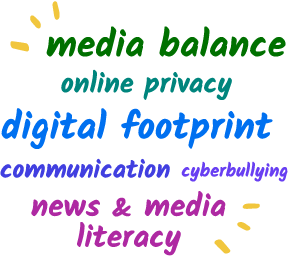
I don’t recall hearing the term digital citizenship until I was in university. Cyber safety was never really addressed in my own schooling. When I was in high school all of my friends had Facebook as an online platform, and some had Twitter. The only time I recall discussing online content was around Pink Shirt Day in discussing Amanda Todd’s story. This is when we discussed how we need to be careful of who we talk to online, what we reveal about ourselves and what we post.
Growing up our family computer was in a common area of our house so my parents could always see what we were up to online. They would see if I was on MSN, YouTube, or using Club Penguin. As I entered high school I had my own device where I downloaded Facebook. My parents never really discussed cyber safety with me either. I think this all was fairly new to the adults in our lives as it was to us kids.
Knowing what I know about our world, digital citizenship and cyber safety, I think having conversations around these topics are crucial to the youth of our society today. Our world is very much connected through online content. Children are exposed to the online world at such a young age. Adults need to fully understand the term digital citizenship and how to navigate it in a positive and safe way to guide children.
The article on the Nine Elements of Digital Citizenship defines digital citizenship as “the continuously developing norms of appropriate, responsible, and empowered technology use.” What I love about this definition is that it uses the phrase “continuously developing,” because that is exactly what out digital world is. It is constantly changing and evolving throughout time and with that the definition of digital citizenship needs to evolve too. The Nine Elements identified are:
- Digital Access
- Digital Commerce
- Digital Communication and Collaboration
- Digital Etiquette
- Digital Fluency
- Digital Health and Welfare
- Digital Law
- Digital Rights and Responsibility
- Digital Security and Privacy
As I read through the Nine Elements and reflect through the online world I know and see, I understand that it is important to discuss each of these elements beginning at a young age. I teach grades one and two, so I will use those grades as an example for how I would approach digital citizenship.

I found a resource with a series of videos called “Meet the Digital Citizens” and lesson plan ideas geared towards children grades K-3. It discusses themes such as media balance, privacy and safety, being responsible, identity, communication, bullying, and media literacy. These concepts are all embedded into the Nine Elements shown above. Planting the seed of these ideas at a young age when kids are using devices to go on YouTube and play games involving chats is very important. There is a lot of content and pop ups on YouTube that are not necessarily safe or appropriate for children to view and hacking is always a possibility when we use any online tool. Children need to learn about safety, know about privacy and what their responsibility and digital footprint is when they are online. Asking a grownup when something doesn’t feel right is always a good idea.
What resources have you found that could be used in the classroom? Have you thought about how you would approach this topic towards kids as young as five years old? How can you adapt the conversation to be age appropriate and effective?